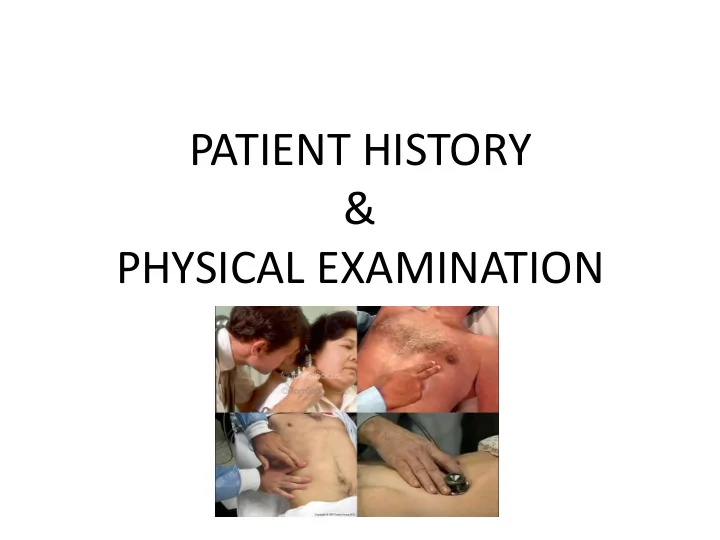

PATIENT HISTORY & PHYSICAL EXAMINATION
Making a diagnosis 1. Anamnesis = history taking 2. Physical examination – inspection, palpation, percussion, auscultation, vital signs, weight, height 3. Working diagnosis - preliminary dg., diff. dg. considerations 4. Further diagnostic examinations – lab, endoscopy, X-ray, EKG etc. 5. Final diagnosis 6. Therapy
Making a diagnosis 1. Anamnesis = history taking 2. Physical examination – inspection, palpation, percussion, auscultation, vital signs, weight, height 3. Working diagnosis - preliminary dg., diff. dg. considerations 4. Further diagnostic examinations – lab, endoscopy, X-ray, EKG etc. 5. Final diagnosis 6. Therapy
Patient history • Generally – Summary of all data regarding the patient’s health from birth to present. – Direct vs. indirect • Rules: 1. Create an atmosphere of confidence and trust a) Privacy b) Comfortable environment c) Eliminate haste/stress 2. Ask open questions 3. Let the patient choose his/her own words
Patient history 1. Personal data • name, address, date of birth, referring physician, next of kin 2. Chief complaint 3. Social status • occupation, family, daily function, … 4. Medical history a) Family illnesses – parents, siblings, children b) Prior illnesses – in chronologic order. Duration, treatment, complications c) Present illnesses – onset, symptoms, course of symptoms, present status 5. Review of systems • Skin, head, eyes, ears, nose, mouth, throat, respiratory tract, cardiovascular + lymphatics, GIT, urinary tract, genitalia, locomotor, nervous, psychological state, endocrine, allergies • Natural functions: voiding, defecation, eating habits/weight changes, sleep 6. Stimulantia • Tobacco, alcohol, drug abuse etc. 7. Medication • All drugs, strength, doses, duration
Physical examination • Basic methods A. Inspection • Pigmentation, asymmetry, oedemas, scars • Lesions, erythemas, hematomas etc B. Palpation • Skin, muscle tonus, temperature, moisture • Superficial vs. deep • Pain, masses C. Percussion • Indirect percussion – “ finger on finger” • Superficial vs. deep • Quality of sound: resonance, hyperresonance, tympanity, flatness, dullness • Borders D. Auscultation • Indirect – stethoscope with membrane and bell • Heart, lungs, intestines, vessels E. Smell • Hygiene, ketoacidosis, alcohol, bad breath, foetor hepaticus
Physical examination • General examination (general impression) – Mental state, voice, speech, nutrition, posture, walk • Skin – Pigmentations, rashes, moisture, elasticity – Scars, hematomas, hemorrhages, erythemas • Head – Direct percussion of skull – CN V exit points – tenderness? – CN VII – make grimaces – CN XII – protrude tongue – Eyes: conjunctiva, pupils round and equal (CN III) – anisocoria?, symmetric accommodation reflex and reaction to light, movements, eyelids – Mouth: teeth (prostheses), moist and clean mucosa and tongue, central cyanosis • Neck – Stiffness – Venous congestion – Palpable gl. thyreoidea – Carotid stenosis – Lymph nodes
Physical examination • Thorax – Normal shape and movements, breathing – Breasts • description in women >40 years • Tenderness, masses, skin changes • symmetry of areolae, discharge – Axilla • Lymph nodes – Heart • Normal heart sounds, clean tones, no murmurs, respiratory arrhythmia – Lungs • Breathing sounds (stridor?) and frequency, resonant percussion, borders • Auscultation sounds - alveolar vs. tubal breathing, wet or dry sounds, friction murmur • Spine – Pain, stiffness, asymmetry – lordoses/ kyphoses/ scolioses – Ex. Schober’s distance test, Stibor’s distance test
Physical examination • Abdomen – Symmetry: any signs of enlargements or masses? Hernia? – Dilated veins – caput medusae – Palpation: texture, tenderness/pain?, palpable spleen or liver? – borders, palpable masses or possible tumors? • Appendicitis: Rowsing’s sign – palpation of LEFT hypogastrium Plenie’s symptom – percussion tenderness of right hypogastrium » – Percussion: borders of liver/spleen, tympanites?, ascites? – Direct percussion of flanks – kidney tenderness? – Auscultation: intestinal sounds – Urinary bladder
Physical examination • Ext. genitalia – tumors, rash, discharge, pain – Testes • Rectal exploration – normal tonus of sphincter, tumors – Prostata: size (walnut), shape, consistency – Brown faeces on glove
Physical examination • Upper extremities – Radial pulse – Raynaud’s phenomenon (SLE) – Finger clubbing • Lower extremities – Pulse of a. dorsalis pedis and a. tibialis posterior – Ischemia – diabetic microangiopathy – Edema, varicose veins – Lymphedema - elephantiasis
Physical examination • BASIC NEUROLOGICAL EXAMINATION A. Cranial nerves • N. olfactorius: rarely examined, smell • N. opticus: normal visual fields, read letters on table, ophtalmoscopy • N. oculomotorius: round pupils, reaction to light and accommodation • N. trochlearis: no ptosis, paresis, deviation, nystagmus • N. abducens: no pareses, double vision, movements (follow the finger), normal saccadic movements • N. trigeminus: normal sensibility for pain and touch in all three branches • N. facialis: Asymmetry of face, normal force of muscles of forehead, eyes, nose, mouth. Sentral vs. peripheral paresis • N. vestibulocochlearis: Normal hearing, conduction through air better than through bone • N. glossopharyngeus & vagus: normal voice, swallowing, elevation of uvula and soft palate • N. accessorius: turn head and lift shoulders symmetrically against resistance • N. hypoglossus: no deviations upon protrusion of tongue, normal speech
Physical examination B. Mobility • Bradykinesia, dyskinesia, akinesia, tremors • Rigidity, spasticity, hypotonicity C. Force • Muscle force over joints: shoulders, elbows, fist, hip, knee, ankle • Tempo and fine motor skills D. Coordination E. Reflexes • Each side • Biceps, triceps, radial • Patellar, achilles, plantar F. Sensibility • Normal sensibility for pain, touch and temperature G. Balance and walking • Normal walk, stand on heels and toes, rise up from crouching position
Recommend
More recommend